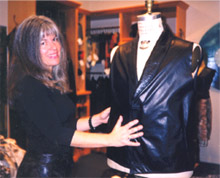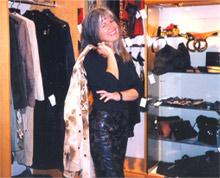 Keeping in touch with her clients is crucial. Brochures should promote the perfect fit of her custom-made leather garments.
By: KAREN E. KLEIN
SPECIAL TO THE TIMES
Keeping in touch with her clients is crucial. Brochures should promote the perfect fit of her custom-made leather garments.
By: KAREN E. KLEIN
SPECIAL TO THE TIMES
Sitting in her cozy sewing nook surrounded by fragrant bolts of leather and suede, with her custom clothing draped festively around the room, Jackie Robbins looks the picture of a successful clothing designer.
For 25 years, Robbins has used her creativity with natural textiles to make and sell jackets, pants, skirts and purses to the Malibu glitterati. Her attractive shop Leather Waves is lined with photos of celebrities like Paul Newman, Neil Diamond, Goldie Hawn and Celine Dion sporting her tailored motorcycle jackets and kicky suede pants.
Robbins applied for a small-business make-over from the Los Angeles Times with the goal of transforming Leather Waves from an artistic endeavor and supplemental income source into the primary means of support.
“I never called clients to solicit business because I didn’t think it was cool to do that,” she said. “Maybe it’s my personality, or maybe it’s because of the whole artist-sensitivity thing. I want people to come to me and seek me out, because they like my art.”
A noble proposition, but no way to run a business, says Bob Phibbs, a Long Beach-based consultant who conducts seminars and advises companies as the Retail Doctor.
To be successful, Phibbs said, Robbins must define herself, her business and her target customers, then use that information to fuel all her strategic planning and marketing decisions. Because of the lack of client data, she could not easily define her target customer.
After some brainstorming, the two settled on the idea that Robbins is an artist who makes personal custom leather garments for clients who are generally middle- to upper-income, fashion-conscious, imaginative men and women with disposable income who can’t find satisfactory garments off-the-rack.
* * *
Because she did not have this definition firmly in the front of her mind, many of Robbins’ recent efforts to enhance sales have gone off track, Phibbs said. For instance, in the last two years, she has developed a brochure, started Leather Waves Babe–a children’s clothing line–and explored wholesaling, but results have been decidedly mixed.
“It’s easy to throw money at stuff, but you can’t just do something to help your business, you have to do the right thing,” Phibbs said.
He designed a sample brochure that walks would-be clients through Robbins’ unique process of garment selection, design sketches, fittings and completion, stressing the perfect fit of custom-made clothing, and says it would be a much more effective marketing tool, especially if she includes pictures of her customers in their finished garments.
* * *
“Don’t cut your prices for anyone, and don’t coupon your services or discount your products to try to win new customers. If they are price-shopping, they aren’t your customers,” he said.
Instead of luring customers with lower prices, Phibbs recommended that she network with other businesses and solicit referrals from retailers in other niches that cater to the same clientele.
Motorcycle shops whose customers do not want off-the-rack leather jackets, custom jewelers and other high-end clothing boutiques might allow her to leave brochures in return for an incentive if they generate referrals, he said.
Even more important than bringing in new customers, Robbins’ top priority should be holding onto existing customers and reconnecting with old customers, Phibbs said.
She needs to build a database from her backlog of client order slips, inputting information about each client’s wants and purchases, and when she last contacted them.
Developing a set of written notes that she can send to these customers during the time they’re working with her and afterward is a must, Phibbs said.
And he recommended that she also send out notes to all her previous customers, just to let them know she’s moved and jog their memory about her designs. Although the task sounds mammoth, if Robbins mails out two notes each business day for a year, she’ll reach a good portion of her clientele. Ongoing mailings will be reasonably simple once her database is complete, Phibbs said.
He suggested that she heavily market her top four best-selling items: a large purse/carrying bag that sells for $350; men’s suede shirts and cargo pants for $750; a custom leather outfit of a jacket and skirt or top with pants for $2,500; and her lightweight shearling coats in a variety of colors that range from $1,000 to $4,000.
“People obviously like the products, and you have a history of making them well,” Phibbs said.
* * *
Robbins is eager to get a Web site up and running, but Phibbs said he sees the Internet as primarily a marketing tool for Leather Waves, because offering custom leather designs on the Internet is impractical. The reason her clients pay a premium, he said, is that Robbins can give them a custom-fit, one-of-a-kind garment that requires a personal relationship.
Putting up pictures of finished garments and customer testimonials, making sure she has an easily recognizable “dot-com” and getting listed in search engines will help her Web site become an effective adjunct to Robbins’ other marketing efforts, he said.
Phibbs also encouraged Robbins to raise her prices, something that she–like most entrepreneurs–was reluctant to do.
So far, the results have been positive. She sent out a dozen letters advertising the deal, and seven called to take advantage of it. She also plans to send out the note cards that Phibbs suggested, and though she said she feels awkward about asking for customers’ pictures and testimonials for her Web site and advertising, she has worked out a photo request and release form and plans to use it.
* * *
Calling recent customers and touching base with them has also been successful.
“It works wonderfully. People are thrilled that I’m calling, and I’m going to do more of it,” Robbins said.
But another of Phibbs’ ideas, contacting some of the celebrities she has recently designed for, makes Robbins uneasy. First, you have to be prepared to pay for a celebrity endorsement with money or merchandise, she said, and second, she considers herself a personal friend of several of her well-known clients and hates to strain the relationship by asking for a favor.
“I don’t want to abuse my relationship with these people–getting to know them is a nice bonus I have from this job,” Robbins said.
Overall, however, Robbins was thrilled with Phibbs’ advice and with other consulting help she has gotten recently, all of which has stimulated her business instincts and gotten her hopes up about Leather Waves’ prospects.
“I’m coming up with new ideas, and there’s excitement generated about my business,” she said. “When you’re at a low creatively and personally, that gets reflected in your business. When your mind is moving creatively in a healthy business direction, then you think creatively, too.”




